6.4: The Archaic Period
- Page ID
- 53002
\( \newcommand{\vecs}[1]{\overset { \scriptstyle \rightharpoonup} {\mathbf{#1}} } \)
\( \newcommand{\vecd}[1]{\overset{-\!-\!\rightharpoonup}{\vphantom{a}\smash {#1}}} \)
\( \newcommand{\dsum}{\displaystyle\sum\limits} \)
\( \newcommand{\dint}{\displaystyle\int\limits} \)
\( \newcommand{\dlim}{\displaystyle\lim\limits} \)
\( \newcommand{\id}{\mathrm{id}}\) \( \newcommand{\Span}{\mathrm{span}}\)
( \newcommand{\kernel}{\mathrm{null}\,}\) \( \newcommand{\range}{\mathrm{range}\,}\)
\( \newcommand{\RealPart}{\mathrm{Re}}\) \( \newcommand{\ImaginaryPart}{\mathrm{Im}}\)
\( \newcommand{\Argument}{\mathrm{Arg}}\) \( \newcommand{\norm}[1]{\| #1 \|}\)
\( \newcommand{\inner}[2]{\langle #1, #2 \rangle}\)
\( \newcommand{\Span}{\mathrm{span}}\)
\( \newcommand{\id}{\mathrm{id}}\)
\( \newcommand{\Span}{\mathrm{span}}\)
\( \newcommand{\kernel}{\mathrm{null}\,}\)
\( \newcommand{\range}{\mathrm{range}\,}\)
\( \newcommand{\RealPart}{\mathrm{Re}}\)
\( \newcommand{\ImaginaryPart}{\mathrm{Im}}\)
\( \newcommand{\Argument}{\mathrm{Arg}}\)
\( \newcommand{\norm}[1]{\| #1 \|}\)
\( \newcommand{\inner}[2]{\langle #1, #2 \rangle}\)
\( \newcommand{\Span}{\mathrm{span}}\) \( \newcommand{\AA}{\unicode[.8,0]{x212B}}\)
\( \newcommand{\vectorA}[1]{\vec{#1}} % arrow\)
\( \newcommand{\vectorAt}[1]{\vec{\text{#1}}} % arrow\)
\( \newcommand{\vectorB}[1]{\overset { \scriptstyle \rightharpoonup} {\mathbf{#1}} } \)
\( \newcommand{\vectorC}[1]{\textbf{#1}} \)
\( \newcommand{\vectorD}[1]{\overrightarrow{#1}} \)
\( \newcommand{\vectorDt}[1]{\overrightarrow{\text{#1}}} \)
\( \newcommand{\vectE}[1]{\overset{-\!-\!\rightharpoonup}{\vphantom{a}\smash{\mathbf {#1}}}} \)
\( \newcommand{\vecs}[1]{\overset { \scriptstyle \rightharpoonup} {\mathbf{#1}} } \)
\( \newcommand{\vecd}[1]{\overset{-\!-\!\rightharpoonup}{\vphantom{a}\smash {#1}}} \)
\(\newcommand{\avec}{\mathbf a}\) \(\newcommand{\bvec}{\mathbf b}\) \(\newcommand{\cvec}{\mathbf c}\) \(\newcommand{\dvec}{\mathbf d}\) \(\newcommand{\dtil}{\widetilde{\mathbf d}}\) \(\newcommand{\evec}{\mathbf e}\) \(\newcommand{\fvec}{\mathbf f}\) \(\newcommand{\nvec}{\mathbf n}\) \(\newcommand{\pvec}{\mathbf p}\) \(\newcommand{\qvec}{\mathbf q}\) \(\newcommand{\svec}{\mathbf s}\) \(\newcommand{\tvec}{\mathbf t}\) \(\newcommand{\uvec}{\mathbf u}\) \(\newcommand{\vvec}{\mathbf v}\) \(\newcommand{\wvec}{\mathbf w}\) \(\newcommand{\xvec}{\mathbf x}\) \(\newcommand{\yvec}{\mathbf y}\) \(\newcommand{\zvec}{\mathbf z}\) \(\newcommand{\rvec}{\mathbf r}\) \(\newcommand{\mvec}{\mathbf m}\) \(\newcommand{\zerovec}{\mathbf 0}\) \(\newcommand{\onevec}{\mathbf 1}\) \(\newcommand{\real}{\mathbb R}\) \(\newcommand{\twovec}[2]{\left[\begin{array}{r}#1 \\ #2 \end{array}\right]}\) \(\newcommand{\ctwovec}[2]{\left[\begin{array}{c}#1 \\ #2 \end{array}\right]}\) \(\newcommand{\threevec}[3]{\left[\begin{array}{r}#1 \\ #2 \\ #3 \end{array}\right]}\) \(\newcommand{\cthreevec}[3]{\left[\begin{array}{c}#1 \\ #2 \\ #3 \end{array}\right]}\) \(\newcommand{\fourvec}[4]{\left[\begin{array}{r}#1 \\ #2 \\ #3 \\ #4 \end{array}\right]}\) \(\newcommand{\cfourvec}[4]{\left[\begin{array}{c}#1 \\ #2 \\ #3 \\ #4 \end{array}\right]}\) \(\newcommand{\fivevec}[5]{\left[\begin{array}{r}#1 \\ #2 \\ #3 \\ #4 \\ #5 \\ \end{array}\right]}\) \(\newcommand{\cfivevec}[5]{\left[\begin{array}{c}#1 \\ #2 \\ #3 \\ #4 \\ #5 \\ \end{array}\right]}\) \(\newcommand{\mattwo}[4]{\left[\begin{array}{rr}#1 \amp #2 \\ #3 \amp #4 \\ \end{array}\right]}\) \(\newcommand{\laspan}[1]{\text{Span}\{#1\}}\) \(\newcommand{\bcal}{\cal B}\) \(\newcommand{\ccal}{\cal C}\) \(\newcommand{\scal}{\cal S}\) \(\newcommand{\wcal}{\cal W}\) \(\newcommand{\ecal}{\cal E}\) \(\newcommand{\coords}[2]{\left\{#1\right\}_{#2}}\) \(\newcommand{\gray}[1]{\color{gray}{#1}}\) \(\newcommand{\lgray}[1]{\color{lightgray}{#1}}\) \(\newcommand{\rank}{\operatorname{rank}}\) \(\newcommand{\row}{\text{Row}}\) \(\newcommand{\col}{\text{Col}}\) \(\renewcommand{\row}{\text{Row}}\) \(\newcommand{\nul}{\text{Nul}}\) \(\newcommand{\var}{\text{Var}}\) \(\newcommand{\corr}{\text{corr}}\) \(\newcommand{\len}[1]{\left|#1\right|}\) \(\newcommand{\bbar}{\overline{\bvec}}\) \(\newcommand{\bhat}{\widehat{\bvec}}\) \(\newcommand{\bperp}{\bvec^\perp}\) \(\newcommand{\xhat}{\widehat{\xvec}}\) \(\newcommand{\vhat}{\widehat{\vvec}}\) \(\newcommand{\uhat}{\widehat{\uvec}}\) \(\newcommand{\what}{\widehat{\wvec}}\) \(\newcommand{\Sighat}{\widehat{\Sigma}}\) \(\newcommand{\lt}{<}\) \(\newcommand{\gt}{>}\) \(\newcommand{\amp}{&}\) \(\definecolor{fillinmathshade}{gray}{0.9}\)Delphi and Greek Treasuries
Delphi was an important cult site for Apollo and was home to many treasuries that housed the community’s offerings to the god.
Describe the treasuries built during the Archaic period in Delphi, with attention to both their style and function
Key Points
- Delphi was an essential city and sanctuary site for the Greeks. Not only was the city the main cult site for Apollo, it was also the home of the Delphic Oracle and the Panhellenic games, known as the Python Games, which honored Apollo’s slaying of the Python.
- The site is known for its numerous treasuries . These treasuries were built by various poleis to house their city-states ‘ offerings and votives to Apollo. The treasuries were small, single-room structures that were decorated to commemorate the deeds of the city.
- The Siphian Treasury was built in an Ionic style in 530 BCE with caryatids instead of columns . The continuous frieze and pediments are high reliefs carved in the Archaic style. The figures on the pediment appear more stiff and rigid than the figures on the frieze, who are engaged in battle.
- The Athenian Treasury was built between 510 and 490 BCE to honor Athenian military power against the Persians. The structure is Doric and while only fragments of the metopes survive, these fragments display the emergence of the naturalism that is found in Archaic sculpture.
Key Terms
- peristyle: An external colonnade surrounding the perimeter of a temple.
- stylobate: The level of a temple platform on which its columns stand.
- triglyph: Three vertically channeled tablets of the Doric frieze in classical architecture, so called because of the angular channels in them.
- tripod: A three-legged stand or mount.
- treasury: A place where state or royal money and valuables are stored.
- gigantomachy: The battle fought between the Titans and the Olympian gods for supremacy of the cosmos.
- columns in antis: The upright posts located between two pillars or piers on either side of a doorway or entrance to a Greek temple.
- metope: A rectangular architectural element that fills the space between two triglyphs in a Doric frieze.
- Panhellenic: Relating to all of Greece or all of the Greeks.
Delphi
The ancient site of Delphi, located in central Greece on the slope of Mt. Parnassus, was known for its Sanctuary of Apollo, the Delphic Oracle, and the Pythian Games. Delphi was home to the dragon Python who protected the navel of the earth.
Apollo slew the Python, establishing his presence at the site. The Panhellenic Pythian games that were held every four years, along with musical compositions , commemorated Apollo’s victory over the beast.
Not only was the site the main place of worship for the god Apollo, it was also the home of an oracle. The oracle was a sibyl or priestess known as a Pythia.
According to myth, when Apollo slew the Python, the creature’s body fell into a fissure and began decomposing. The oracle would place her tripod seat over the fissure, inhale the fumes, and then would be possessed by Apollo, allowing him to speak through her.
The Delphic Oracle was an essential part of Greek life and was consulted for matters public and private, small and large, and so had commanding power over the lives of the Greeks. The oracle’s prophecies were usually unintelligible and would be translated into poetic meter by priests.
Temple of Apollo
The site of Delphi is dominated by a central Temple of Apollo, a fourth-century BCE replacement of the Archaic sixth-century temple. One peristyle of Doric columns (the order used in Archaic architecture) surrounded the perimeter of the stylobate that rested atop two steps.
Inside the Temple of Apollo was the seat of the Pythia, in a small restricted room in the back of the naos , known as an adyton, which translates to English as not to be entered.
There was also a large theater built into the hillside located just above the Temple of Apollo. The theater was first built in the fourth century BCE and renovated multiple times in the following centuries. It could seat 5,000 spectators and offered a view of the entire sanctuary site and the valley.
Treasuries
The road leading up to the sanctuary site of Apollo was lined with votive statues and treasuries. The treasuries were built by different poleis to honor the oracle, thank her for her advice, and commemorate military victories. These small, temple-like structures held the votives and offerings made to Apollo as well as a small proportion of the spoils won from battle from each polis . Because the buildings held a wealth of materials and goods, they are known as treasuries. These buildings were single-room naosoi (plural of naos) fronted by two columns in antis and decorated in either the Doric or Ionic style.
Siphnian Treasury
The Siphnian Treasury was built for the polis of Siphnos, a city-state that occupied a Cycladic island. The Siphnians had large gold and silver mines, from which they profited enormously, and they used the profits to erect their treasury at Delphi.
The treasury housed their gold and silver gifts to the gods. The Siphian Treasury was the first structure built entirely from marble when it was erected in 530 BCE and was elaborately decorated.
The two columns in the antis were not typical columns but caryatids, support columns that took the shape of women. A continuous Ionic frieze that wrapped around the top of the treasury beneath the pediment depicted scenes from Greek mythology, including a gigantomachy on the north side, the Judgment of Paris on the west side, and gods watching the sack of Troy by the Greeks on the south and east sides.
The east pediment recounts the story of Herakles stealing Apollo’s tripod, which visually connects the pediment and the treasury to the oracle site at the Temple of Apollo.

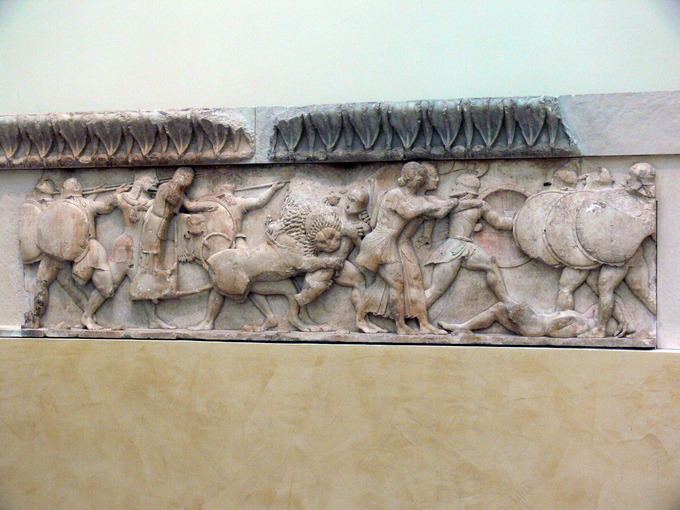
The figures are carved in an Archaic style and in high relief, and they are almost, but not entirely, freed from the wall of the frieze. While the figures appear to be in motion, with wide stances and arms open wide for battle, the majority of them stand with both feet flat on ground . This inhibits the sense of motion given by the rest of their bodies.
The pedimental figures are especially rigid and linear, although the figures are no longer scaled to fit into the small corners of the pediment. When looking at these figures, from the front they appear to appropriately model the body, while from the side the figures appear block-like, emphasizing the fact that they were carved from stone.
Athenian Treasury
The Athenian treasury at Delphi was built between 510 and 480 BCE to commemorate the Athenian victory over the Persians during the Battle of Marathon. Like the Siphnian Treasury, the Athenian Treasury was constructed entirely of marble.
The treasury has Doric columns and a frieze of triglyphs and thirty metopes that depict scenes from the life of Theseus, an Athenian mythological hero, and Herakles. The metopes also display the development of Archaic relief and temple decoration. The figures do not feel forced into their frame but instead begin to fill out the scene.
Most of the scenes consist of only two characters and few scenes, such as Herakles fighting the Ceryean Hind (an enormous deer), display a new sense of ingenuity. The figure of Herakles breaks out of the frame as he leans on the hind’s back, trying to catch it. Furthermore, the figures, unlike those on the Siphnian pediment, appear modeled from all sides, as opposed to just frontally.
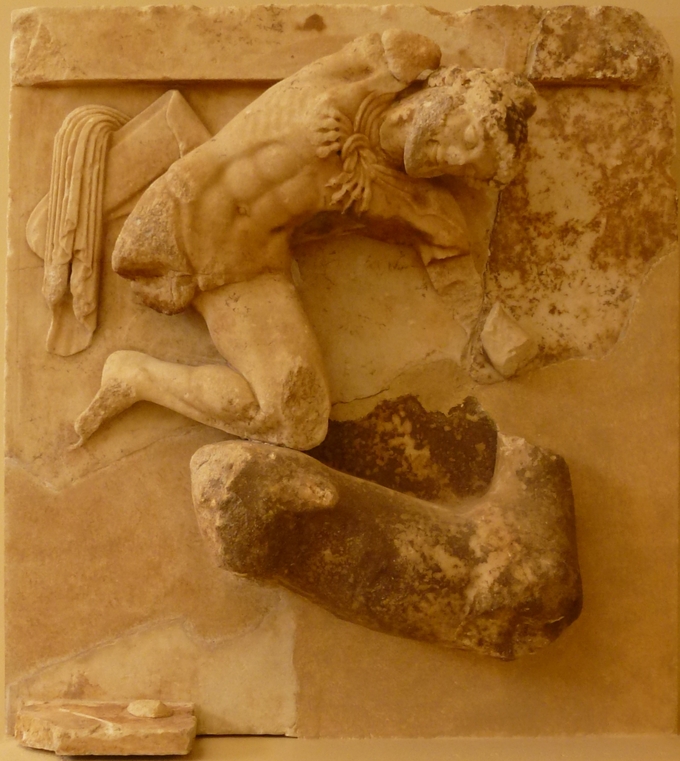
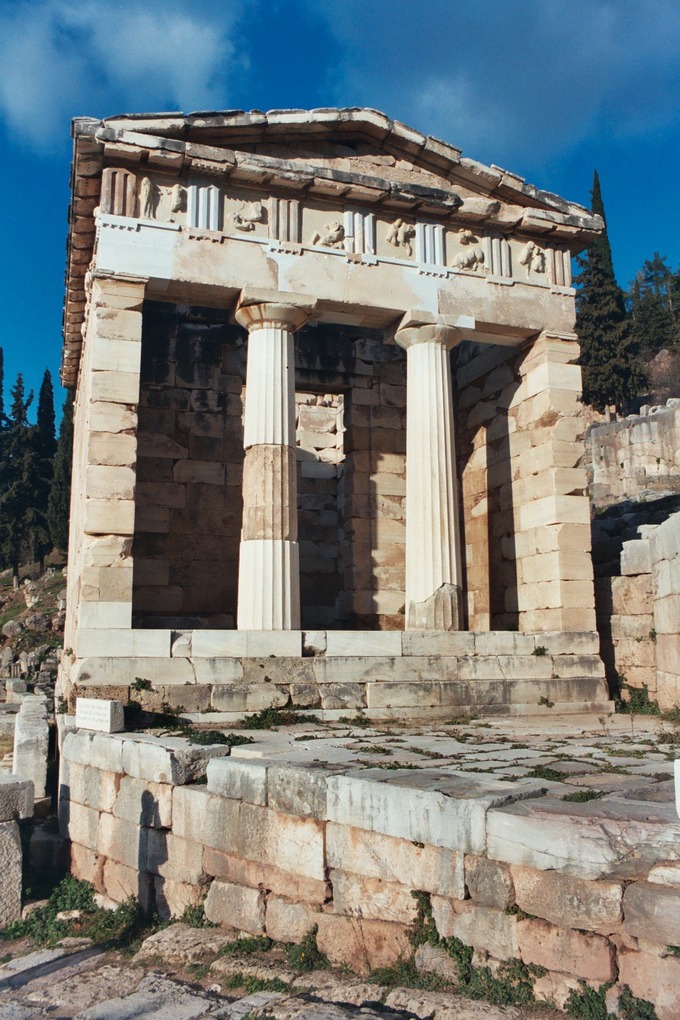
Temple Architecture in the Greek Archaic Period
The temples of the Archaic period are the first stone temples built in Greece. They demonstrate a developing knowledge of stone building through their use of decorative spaces on buildings.
Explain the sculptural design choices on different areas of the temples: identify the naos, pronaos, prostyle, antae, and opisthodomos, and indicate the specific features that were characteristic of the Doric order
Key Points
- The design of Greek stone temples was influenced by Mycenaean megarons (a porch with columns in antis and a central room) and their earlier wooden temples. Many decorative elements, such as the triglyphs , replicated the visual design of wooden temples in stone.
- During the Archaic period, the Greeks began to develop the ideal temple design. It included a central naos surrounded on two ends by an opisthodomos and a pronaos , but accessed only through the pronaos. These rooms were surrounded by a peripteral colonnade on a raised platform with two or three steps.
- The Doric order is the oldest Greek classification of architecture. It is identified by its columns and its frieze . The columns had no base, a bulge in the middle of their shaft , and squashed, flared capitals . The frieze was divided by triglyphs and metopes.
- Designers utilized the spaces on the metopes to depict individual mythological events on earlier temples, and then as a collective series of moments in an event, such as the Twelve Labors of Herakles on the Temple of Zeus at Olympia. The pedimental spaces were also used to depict heroic or mythological events at either end of the temples. The Temple of Hera I and the Temple of Hera II at Paestum, Italy demonstrated the development of the Doric style from its earliest stage through various refinements as the Greeks became more comfortable with building in stone.
- The Temple of Aphaia at Aegina is one of the last temples whose design did not conform to the architectural standards of the time.
Key Terms
- peripteral: Surrounded by a single row of columns.
- naos: The inner chamber of a temple that housed the cult statue. Also known as a cella.
- megaron: The rectangular great hall in a Mycenaean building, usually supported with pillars.
- pediment: The triangular space left above the frieze by the shape of the roof at the narrowest ends of the temple.
- entasis: A slight convex curvature introduced into the shaft of a column for aesthetic reasons, or to compensate for the illusion of concavity.
- stylobate: A raised stone platform on which temples are erected.
- pronaos: The front porch of a temple.
- anta: The post or pillar on either side of a doorway or entrance of a Greek temple.
- opisthodomos: The rear room of a Greek temple.
- votives: Objects displayed or deposited at a sacred place without the intent of recovery or use.
- echinus: A convex molding that commonly bears the egg-and-dart motif.
- entablature: The area of a temple facade that lies horizontally atop the columns.
- triglyph: A decorative panel with three grooves.
- tholos: A circular, colonnaded building, usually a temple.
- metope: A rectangular architectural element that fills the space between two triglyphs in a Doric frieze.
- prostyle: Free-standing columns across the front of a building.
Temples of the Archaic Period
Stone temples were first built during the Archaic period in ancient Greece. Before this, they were constructed out of mud-brick and wood—simple structures that were rectangular or semi-circular in shape—that may have been enhanced with a few columns and a porch. The Archaic stone temples took their essential shape and structure from these wooden temples and the shape of a Mycenaean megaron.
Temple Design
The standard form of a Greek temple was established and then refined through the Archaic and Classical period. Most temples were rectilinear in shape and stood on a raised stone platform, known as the stylobates , which usually had two or three stairs.
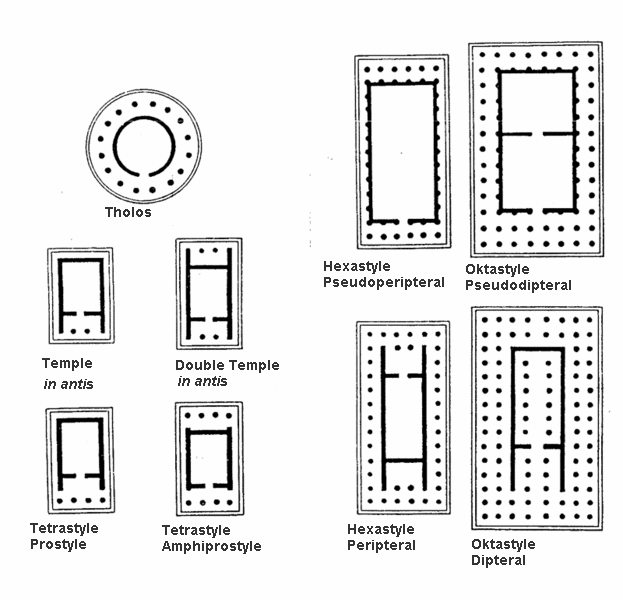
The main portion of the temple was the naos. To the front of the naos was the pronaos, or front porch. A door between the naos and pronaos provided access to the cult statue. Columns, known as prostyle , often stood in front of the pronaos. These were often aligned with molded projections to the end of the pronaos’s wall, called the anta (plural antae). Such aligned columns were referred to as columns in antis.
A rear room, called the opisthodomos, was on the other side of the temple and naos. A wall separated the naos and opisthodomos completely. The opisthodomos was used as a treasury and held the votives and offerings left at the temple for the god or goddess. It also had a set of prostyle columns in antis that completed the symmetrical appearance of the temple.
Other Temple Plans
While this describes the standard design of Greek temples, it is not the most common form found. One notable exception to this standard was the circular tholos , dedicated to Apollo at Delphi. Columns were placed on the edge of the stylobate in a line or colonnade, which was peripteral and ran around the naos (an inner chamber that holds a cult statue) and its porches.
The first stone temples varied significantly as architects and engineers were forced to determine how to properly support a roof with such a wide span. Later architects, such as Iktinos and Kallikrates who designed the Parthenon, tweaked aspects of basic temple structure to better accommodate the cult statue.
Mathematical Scale
All temples, however, were built on a mathematical scale and every aspect of them is related to one another through ratios. For instance, most Greek temples (except the earliest) followed the equation 2x + 1 = y when determining the number of columns used in the peripteral colonnade.
In this equation, x stands for the number of columns across the front, the shorter end, while y designates the columns down the sides. The number of columns used along the length of the temple was twice the number plus one the number of columns across the front. Due to these mathematical ratios, we are able to accurately reconstruct temples from small fragments.
Doric Order
The style of Greek temples is divided into three different and distinct orders, the earliest of which is the Doric order. These temples had columns that rested directly on the stylobate without a base. Their shafts were fluted with twenty parallel grooves that tapered to a sharp point.
The capitals of Doric columns had a simple, unadorned square abacus and a flared echinus that was often short and squashed. Doric columns are also noted for the presence of entasis , or bulges in the middle of the column shaft. This was perhaps a way to create an optical illusion or to emphasize the weight of the entablature above, held up by the columns.
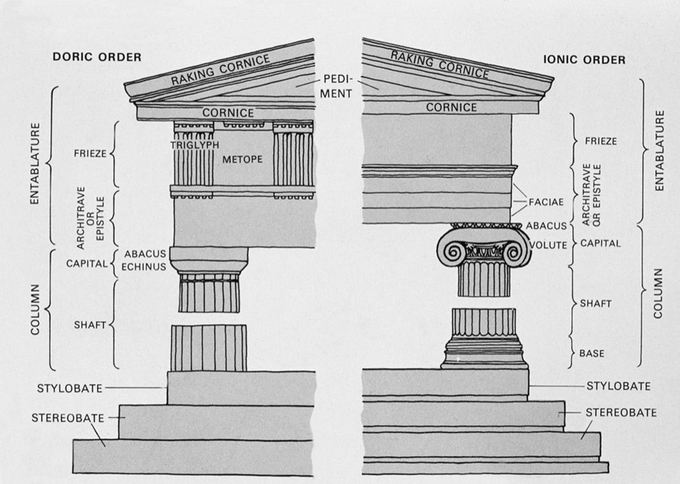
The Doric entablature was also unique to this style of temples. The frieze was decorated with alternating panels of triglyphs and metopes. The triglyphs were decorative panels with three grooves or glyphs that gave the panel its name. The stone triglyphs mimicked the head of wooden beams used in earlier temples. Between the triglyphs were the metopes.
Decorative Spaces
Sculptors used the metope spaces to depict mythological occurrences, often with historical or cultural links to the site on which the temple stood.
On the Temple of Zeus at Olympia (constructed between 470BC and 456BC), the choice to sculpt the Twelve Labors of Herakles was in direct correlation with the site’s Olympic Games and the spirit of triumph in physical challenge. Most sculptors attempted to use the limited and angular space of metopes to show distinct moments that filled the shape, but not all were successful in doing so.
Another space used for decoration was the pediment at each end of the temple. Due to the larger space afforded by these sections, the sculptors often chose to depict larger and more eventful scenes.
The shape of the pediment made it difficult to arrange figures in a coherent and cohesive scene, so the sculptors placed the most prominent ones in the apex (the highest point of the triangle). All of these decorative sculptures would be painted in bright colors and recognizable to onlookers.
Paestum, Italy
The Greek colony at Poseidonia (now Paestum) in Italy, built two Archaic Doric temples that are still standing today .
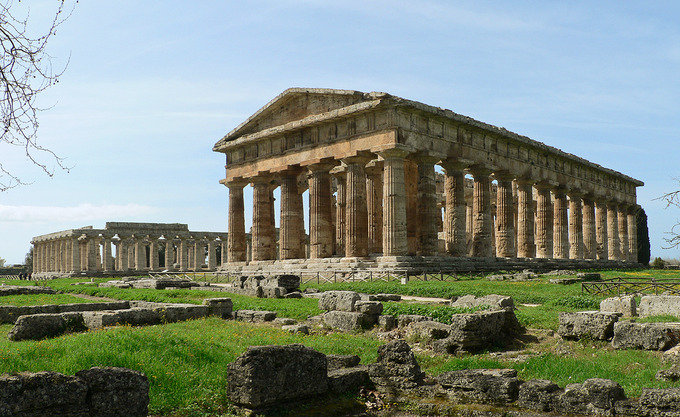
The first, the Temple of Hera I, was built in 550 BCE and differs from the standard Greek temple model dramatically. It is peripteral, with nine columns across its short ends and 18 columns along each side. The opisthodomos is accessed through the naos by two doors. There are three columns in antis across the pronaos. Inside the naos is a row of central columns, built to support the roof.
The cult statue is placed at the back, in the center, and is blocked from view by the row of columns. When examining the columns, they are large and heavy, and spaced very close together. This further denotes the Greeks unease with building in stone and the need to properly support a stone entablature and heavy roof. The capitals of the columns are round, flat, and pancake-like.
The Temple of Hera II, built almost a century later in 460 BCE, began to show the structural changes that demonstrated the Greek’s comfort and developing understanding of building in stone, as well as the beginnings of a Classical temple style.
In this example, the temple was fronted by six columns, with 14 columns along its length. The opisthodomos was separated from the naos and had its own entrance and set of columns in antis. A central flight of stairs led from the pronaos to the naos and the doors opened to look upon a central cult statue. There were still interior columns; however they were moved to the side, permitting prominent display of the cult statue.
Aegina
The temple of Aphaia on the island of Aegina is an example of Archaic Greek temple design as well as of the shift in sculptural style between the Archaic and Classical periods. Aegina is a small island in the Saronic Gulf within view of Athens; in fact, Aegina and Athens were rivals.
While the temple was dedicated to the local god Aphaia, the temple’s pediments depicted scenes of the Trojan War to promote the greatness of the island. These scenes involve the Greek heroes who fought at Troy—Telamon and Peleus , the fathers of Ajax and Achilles.
In an antagonistic move, the battle scenes on the pediments are overseen by Athena, and the temple’s dedicated deity , Aphaia, does not appear on the pediment at all. While very little paint remains now, the entire pediment scene, triglyphs and metopes, and other parts of the temple would have been painted in bright colors.
Temple Design
The Temple of Aphaia is one of the last temples with a design that did not conform to standards of the time. Its colonnade has six columns across its width and twelve columns down its length. The columns have become more widely spaced and also more slender.
Both the pronaos and opisthodomos have two prostyle (free-standing) columns in antis and exterior access, although both lead into the temple’s naos. Despite the connection between the opisthodomos and the naos, the doorway between them is much smaller than the doorway between the naos and the pronaos.
As in the Temple of Hera II, there are two rows of columns on either side of the temple’s interior. In this case there are five on each side, and each colonnade has two stories. A small ramp interrupts the stylobate at the center of the temple’s main entrance.
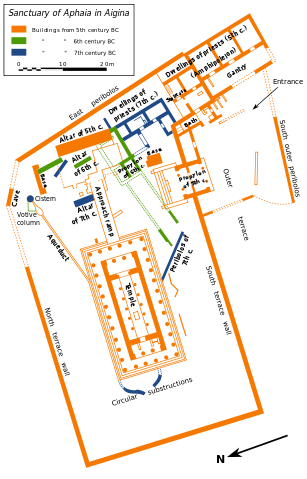
Sculpture in the Greek Archaic Period
Sculpture during the Archaic period became increasing naturalistic, although this varies depending on the gender of the subject.
Compare and contrast the kouroi and korai sculptures of the Archaic period, and recognize the increasing naturalism seen in both free-standing and pedimental sculptures of the Archaic period
Key Points
- Dedicatory male kouroi figures were originally based on Egyptian statues and over the Archaic period these figures developed more naturalistic nude bodies. The athletic body was an ideal form for a young Greek male and is comparable to the ideal body of the god Apollo.
- Instead of focusing on the body, female korai statues were clothed and throughout the Archaic period artists spent more time elaborating on the detailed folds and drapery of a woman’s clothing. This reflected the Greek ideals for women, who were supposed to be fully clothed, modest, and demure.
- To add an additional naturalistic element to the body, the typical Archaic smile was added to both male and female statues. While today the smile seems false, to the ancient Greeks it added a level of realism.
- Pedimental sculpture in the Archaic period was often scaled to fit into the space of the pediment and served an apotropaic instead of a decorative function.
- Pedimental sculptures from the Temple of Aphaia at Aegina show a gradual move toward the naturalism of the Classical style that followed the Archaic.
Key Terms
- Archaic smile: A stylized expression used in sculpture from 600 to 480 BCE to suggest a sense of lifelikeness in the subject.
- peplos: An Ancient Greek garment, worn by women, made of a tubular piece of cloth that is folded back upon itself halfway down, until the top of the tube is worn around the waist, and the bottom covers the legs down to the ankles; the open top is then worn over the shoulders, and draped, in folds, down to the waist.
- apotropaic: Intended to ward off evil.
- kouros: A sculpture of a naked youth in Ancient Greece; the male equivalent of a kore.
- kore: An Ancient Greek statue of a woman, portrayed standing, usually clothed, painted in bright colors, and having an elaborate hairstyle.
- chiton: A loose, woolen tunic, worn by both men and women in Ancient Greece.
Sculpture in the Archaic Period
Sculpture in the Archaic Period developed rapidly from its early influences, becoming more natural and showing a developing understanding of the body, specifically the musculature and the skin. Close examination of the style’s development allows for precise dating.
Most statues were commissioned as memorials and votive offerings or as grave markers, replacing the vast amphora (two-handled, narrow-necked jars used for wine and oils) and kraters (wide-mouthed vessels) of the previous periods, yet still typically painted in vivid colors.
Kouroi
Kouroi statues (singular, kouros ), depicting idealized, nude male youths, were first seen during this period. Carved in the round , often from marble, kouroi are thought to be associated with Apollo; many were found at his shrines and some even depict him. Emulating the statues of Egyptian pharaohs, the figure strides forward on flat feet, arms held stiffly at its side with fists clenched. However, there are some importance differences: kouroi are nude, mostly without identifying attributes and are free-standing.
Early kouroi figures share similarities with Geometric and Orientalizing sculpture, despite their larger scale. For instance, their hair is stylized and patterned, either held back with a headband or under a cap. The New York Kouros strikes a rigid stance and his facial features are blank and expressionless. The body is slightly molded and the musculature is reliant on incised lines .
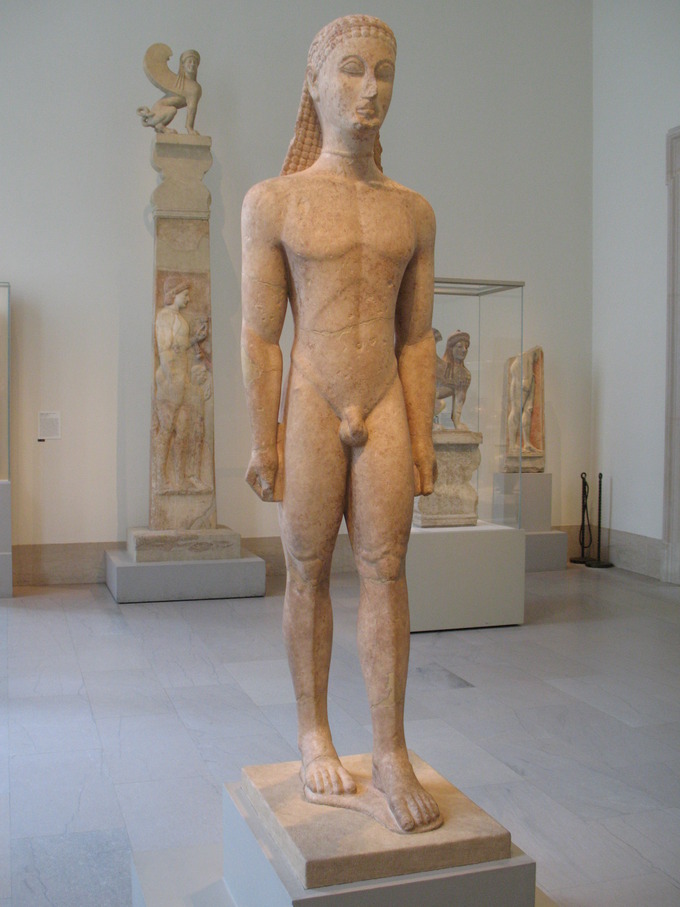
As kouroi figures developed, they began to lose their Egyptian rigidity and became increasingly naturalistic. The kouros figure of Kroisos, an Athenian youth killed in battle, still depicts a young man with an idealized body. This time though, the body’s form shows realistic modeling.
The muscles of the legs, abdomen, chest and arms appear to actually exist and seem to function and work together. Kroisos’s hair, while still stylized, falls naturally over his neck and onto his back, unlike that of the New York Kouros, which falls down stiffly and in a single sheet. The reddish appearance of his hair reminds the viewer that these sculptures were once painted.
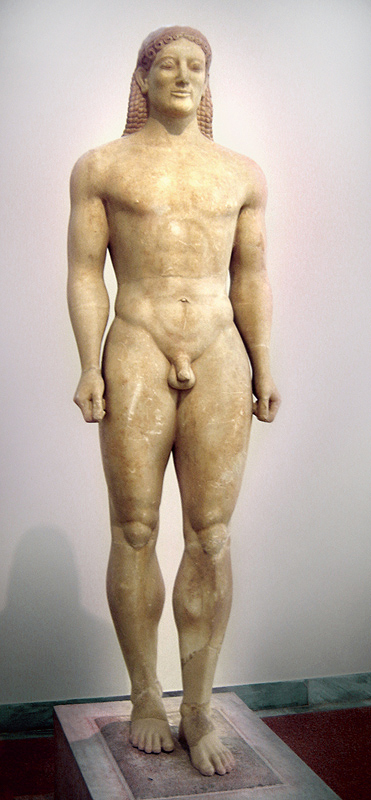
Archaic Smile
Kroisos’s face also appears more naturalistic when compared to the earlier New York Kouros. His cheeks are round and his chin bulbous; however, his smile seems out of place. This is typical of this period and is known as the Archaic smile. It appears to have been added to infuse the sculpture with a sense of being alive and to add a sense of realism.
Kore
A kore (plural korai) sculpture depicts a female youth. Whereas kouroi depict athletic, nude young men, the female korai are fully-clothed, in the idealized image of decorous women. Unlike men—whose bodies were perceived as public, belonging to the state—women’s bodies were deemed private and belonged to their fathers (if unmarried) or husbands.
However, they also have Archaic smiles, with arms either at their sides or with an arm extended, holding an offering. The figures are stiff and retain more block-like characteristics than their male counterparts. Their hair is also stylized, depicted in long strands or braids that cascade down the back or over the shoulder.
The Peplos Kore (c. 530 BCE) depicts a young woman wearing a peplos, a heavy wool garment that drapes over the whole body, obscuring most of it. A slight indentation between the legs, a division between her torso and legs, and the protrusion of her breasts merely hint at the form of the body underneath.
Remnants of paint on her dress tell us that it was painted yellow with details in blue and red that may have included images of animals. The presence of animals on her dress may indicate that she is the image of a goddess, perhaps Artemis, but she may also just be a nameless maiden.
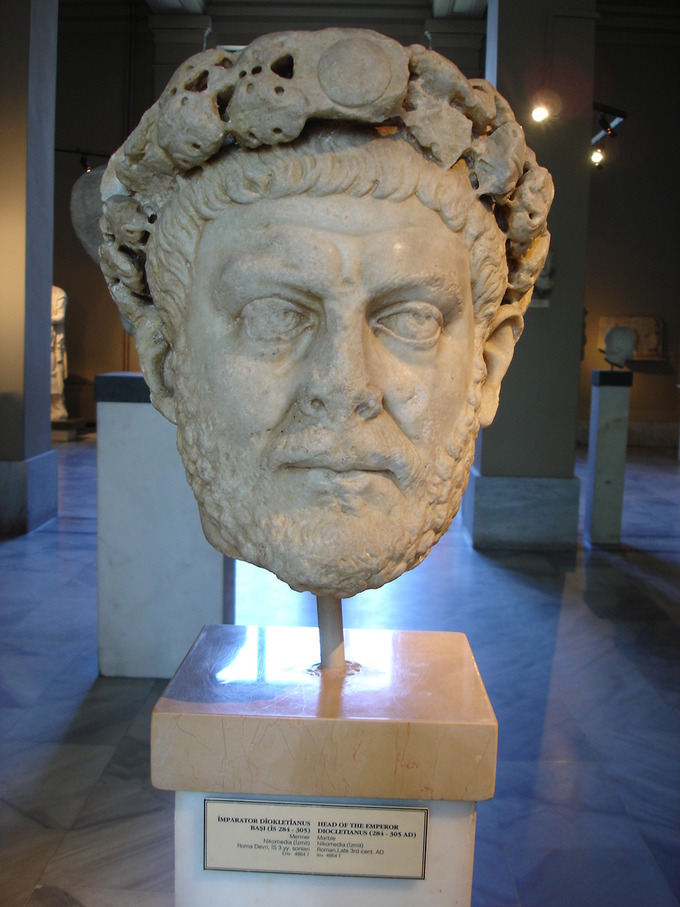
Later korai figures also show stylistic development, although the bodies are still overshadowed by their clothing. The example of a Kore (520–510 BCE) from the Athenian Acropolis shows a bit more shape in the body, such as defined hips instead of a dramatic belted waistline, although the primary focus of the kore is on the clothing and the drapery. This kore figure wears a chiton (a woolen tunic), a himation (a lightweight undergarment), and a mantle (a cloak). Her facial features are still generic and blank, and she has an Archaic smile. Even with the finer clothes and additional adornments such as jewelry, the figure depicts the idealized Greek female, fully clothed and demure.
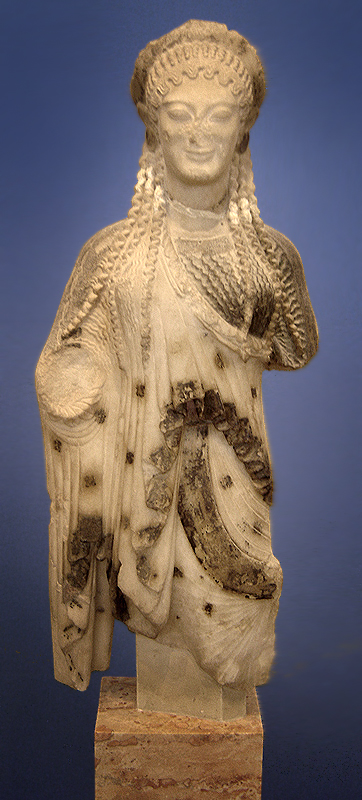
Pedimental Sculpture: The Temple of Artemis at Corfu
This sculpture, initially designed to fit into the space of the pediment, underwent dramatic changes during the Archaic period, seen later at Aegina. The west pediment at the Temple of Artemis at Corfu depicts not the goddess of the hunt, but the Gorgon Medusa with her children; Pegasus, a winged horse; and Chrysaor, a giant wielding a golden sword surrounded by heraldic lions.
Medusa faces outwards in a challenging position, believed to be apotropaic (warding off evil). Additional scenes include Zeus fighting a Titan, and the slaying of Priam, the king of Troy, by Neoptolemos. These figures are scaled down in order to fit into the shrinking space provided in the pediment.
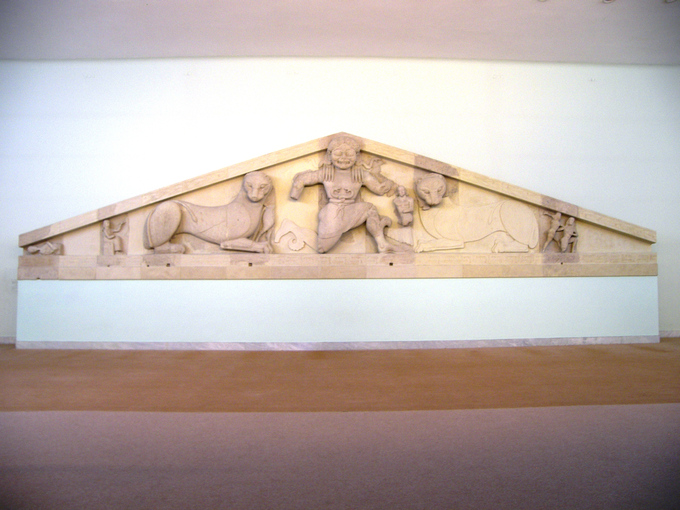
Pedimental Sculpture: The Temple of Aphaia at Aegina
Sculpted approximately one century later, the pedimental sculptures on the Temple of Aphaia at Aegina gradually grew more naturalistic than their predecessors at Corfu. The dying warrior on the west pediment (c. 490 BCE) is a prime example of Archaic sculpture. The male warrior is depicted nude, with a muscular body that shows the Greeks’ understanding of the musculature of the human body. His hair remains stylized with round, geometric curls and textured patterns.
However, despite the naturalistic characteristics of the body, the body does not seem to react to its environment or circumstances. The warrior props himself up with an arm, and his whole body is tense, despite the fact that he has been struck by an arrow in his chest. His face, with its Archaic smile, and his posture conflict with the reality that he is dying.
Aegina: Transition between Styles
The dying warrior on the east pediment (c. 480 BCE) marks a transition to the new Classical style. Although he bears a slight Archaic smile, this warrior actually reacts to his circumstances. Nearly every part of him appears to be dying.
Instead of propping himself up on an arm, his body responds to the gravity pulling on his dying body, hanging from his shield and attempting to support himself with his other arm. He also attempts to hold himself up with his legs, but one leg has fallen over the pediment’s edge and protrudes into the viewer’s space. His muscles are contracted and limp, depending on which ones they are, and they seem to strain under the weight of the man as he dies.
Ceramics in the Greek Archaic Period
Archaic black- and red-figure painting began to depict more naturalistic bodies by conveying form and movement.
Describe the similarities and differences between black- and red-figure painting during Greece’s Archaic Period
Key Points
- Black-figure painting was used throughout the Archaic period before diminishing under the popularity of red-figure painting.
- Exekias is considered one of the most talented and influential black-figure painters due to his ability to convey emotion, use intricate lines , and create scenes that trusted the viewer to comprehend the scene.
- Red-figure painting was developed in 530 BCE by the Andokides Painter, a style that allows for more naturalism in the body due to the use of a brush.
- The first red-figure paintings were produced on bilingual vases, depicting one scene on each side, one in black figure and the other in red figure.
- The painters Euthyides and Euphronios were two of the most talented Archaic red-figure painters, with their vessels depict space , movement, and naturalism.
Key Terms
- burin: A chisel with a sharp point, used for engraving; an engraver.
- slip: A thin, slippery mix of clay and water.
- red-figure: One of the most important styles of figural Greek vase painting, based on the figural depictions in red color on a black background.
- black-figure: A style of Greek vase painting that is distinguished by silhouette-like figures on a red background.
Pottery Decoration Overview
The Archaic period saw a shift in styles of pottery decoration, from the repeating patterns of the Geometric period , through the Eastern-influenced Orientalizing style, to the more naturalistic black- and red-figure techniques. During this time, figures became more dynamic and defined by more organic—as opposed to geometric—elements.
Black-Figure Painting
Black-figure painting, which derives its name from the black figures painted on red backgrounds, was developed by the Corinthians in the seventh century BCE and became popular throughout the Greek world during the Archaic period. As painters became more confident working in the medium , human figures began to appear on vases and painters and potters began signing their creations.
The François Vase
One of the most famous early Athenian black-figure pots is a large volute krater by the potter Ergotimos and the painter Kleitias, known as the François Vase. The krater, named for the man who discovered it in the nineteenth century, depicts 270 figures on the six registers that wrap around the krater.
Unlike the monumental vases of the Geometric period, this krater stands at 66 cm (2.17 feet) tall. The surface depicts various mythological scenes with many figures labeled by name. On one side of the krater’s neck are scenes from the Calydonian Boar hunt, in which several men and a powerful woman named Atalanta hunted and killed a monstrous boar sent by Artemis to terrorize the region of Calydon after the king offended her.
The other side depicts Theseus, who slayed the Minotaur , with Athenian youths and his wife Ariadne. Other registers depict scenes of the Trojan War and Peleus with his son Achilles. The detail and skill demonstrate new styles of Archaic vase painting, shifting away from past centuries’ animal motifs and geometric patterns.
Instead of filling negative space with patterns and geometric designs, Kleitias leaves areas empty. The people and horses are depicted differently than Oriental and Geometric prototypes. Bodies are more accurately rendered and less dependent on geometric shapes, although profile views dominate, and sharp lines provide texture for musculature and clothing. While many figures still stand flat-footed, the limbs of people, horses, and centaurs show movement and are dramatic compositions within the confines of the style.
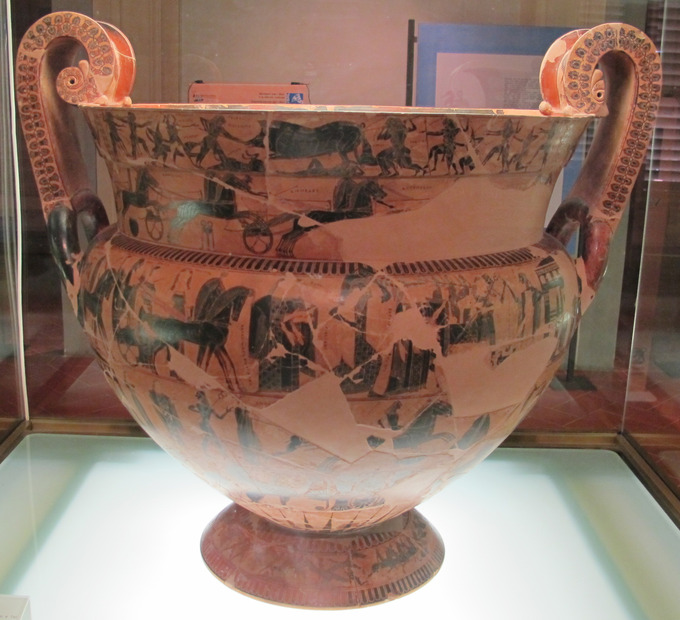
Exekias
Exekias, considered the most prominent black-figure painter of his time, worked between 545 and 530 BCE in Athens. He is regarded by art historians as an artistic visionary whose masterful use of incision and psychologically sensitive compositions mark him as one of the greatest of all Attic vase painters. His vessels display attention to detail and precise, intricate lines.
Exekias is also well-known for reinterpreting mythologies. Instead of providing the entire story, as Kleitias did on the François Vase, he paints single scenes and relies on the viewer to interpret and understand the narrative.
One example is an amphora that depicts the Greek warriors Achilles and Ajax playing dice. Both men are decorated with fine incised details, showing elaborate textile patterns and almost every hair in place. As they wait for the next battle with the Trojans, their game foreshadows their fates. Inscribed text allows the two figures to speak: “Achilles has rolled a four, while Ajax rolled a three.” Both men will die during the the Trojan War, but Achilles dies a hero while Ajax is consistently considered second best, eventually committing suicide.
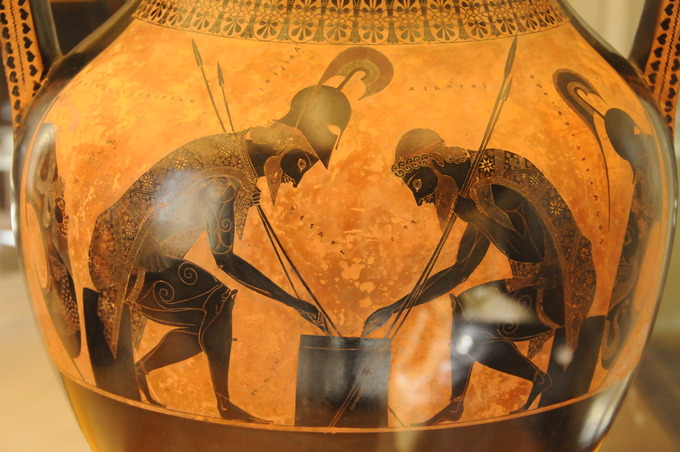
Red-Figure Painting
Red-figure painting developed in Athens in 530 BCE and remained popular into the Classical period. The technique is similar to black-figure painting but with key differences.
Instead of painting a figure with black slip and using a burin to scrape away the slip to create details, red-figure painting has the background painted black and the figures left the red color of the terra cotta . Black slip was painted with a brush to add detail.
Brushes could achieve more fluid lines than a burin, so details were better rendered and figures became livelier than the black-figure silhouettes. The black slip could also be diluted with water to create shades for modeling bodies or clothing. Overall, the technique allowed vase painters to create compositions that rendered the body more naturally.
Bilingual Painting
Bilingual vase painting became popular with the advent of red-figure painting. Bilingual vases were painted with a single scene on each side of the vessel, usually the same scene rendered twice. One side depicts the scene in black-figure and the other side depicts the scene in red-figure.
The Andokides Painter is credited as the inventor of red-figure style and its early production on bilingual vases. Several of his bilingual amphorae mimic some of Exekias’s most famous subjects, such as Achilles and Ajax playing dice. These similarities lead many scholars to conclude that he was Exekias’s student.
A score of vases with black figures, whose attribution is disputed by some researchers, show that the Andokides painter gradually attained greater control and virtuosity in the technique. Earlier examples appear a little stiff. Later, the artist exploits the benefits inherent in the technique and utilizes a range of colors from red to dark brown.
The Andokides painter marked the arrival of the red-figure style that was later used by many artists. The painter’s most favored subject matter was a wide range of mythological scenes that depicted the gods and heroes. Heracles was his favorite character.
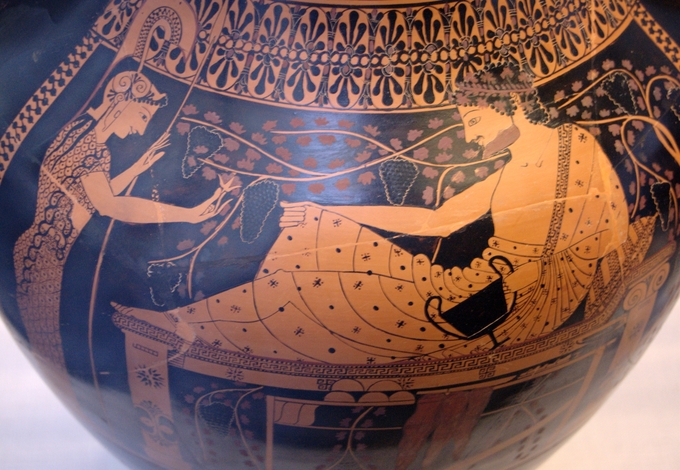
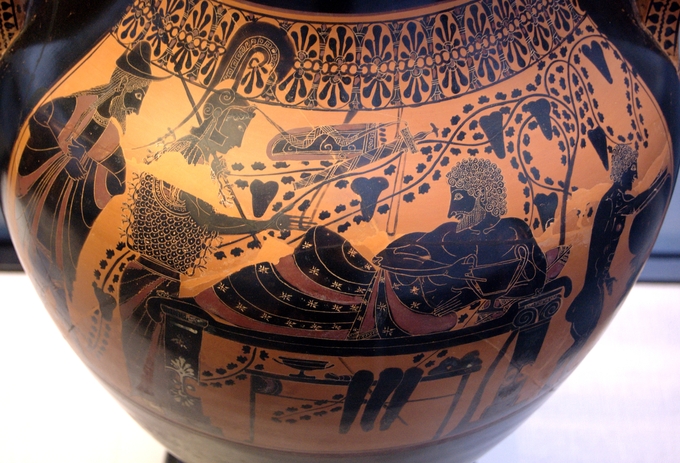
Additional Red-Figure Painters
Additional red-figure painting can be seen in the work of the rivals Euthymides and Euphronios. Euthymides is known as a pioneer of red-figure painting.
His vessels depict people in movement and he attempted perspective by showing figures with foreshortened limbs. The Revelers Vase is an amphora that depicts three drunk men dancing. While the figures do not overlap, the bodies are in shown in profile, three-quarter view, and from behind.
Breaking the traditional rigidity of contemporary Archaic statues and paintings, the revelers are in dynamic postures. The two outer figures stand in active stances, with their legs and hands in motion. The middle figure is in a twisted position, with his back to the viewer and his head looking over his left shoulder. The use of foreshortening , although rudimentary, gives the entire composition a more natural and believable feel. It is perhaps the use of this relatively untried technique that led Euthymides to write on his vase, “As never Euphronios [could do!]” as a taunt to his contemporary and rival.
The painter Euphronios is also recognized for his dramatic and complex compositions. He used diluted clay slip to create a range of shades to color his figures, making them appear energetic and present in three-dimensional space.
A scene of Herakles and Antaios wrestling conveys the bodies of both men with previously unseen naturalism. The men’s bodies bend and twist and their limbs overlap, disappear and reappear, which helps achieve both naturalism as well as a sense of space.
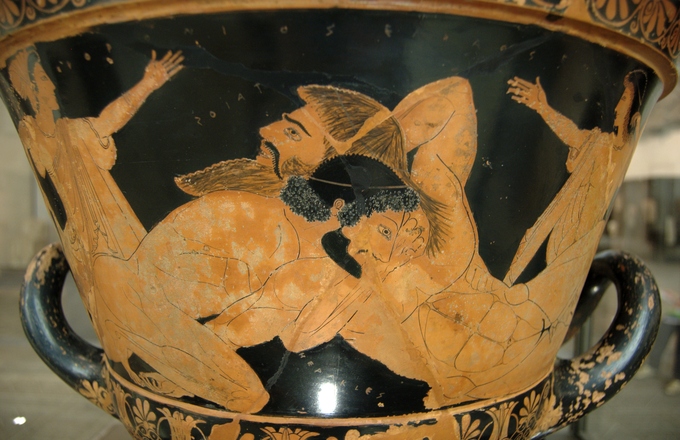
- Curation and Revision. Provided by: Boundless.com. License: CC BY-SA: Attribution-ShareAlike
- Treasury of Athens at Delphi. Provided by: Wikimedia. Located at: commons.wikimedia.org/wiki/File:Treasury_of_Athens_at_Delphi.jpg. License: CC BY: Attribution
- The dispute between Herakles and Apollo-Delphi. Provided by: Wikimedia. Located at: commons.wikimedia.org/wiki/File:The_dispute_between_Herakles_and_Apollo-Delphi.jpg. License: CC BY-SA: Attribution-ShareAlike
- 640px-The_Temple_of_Apollo_at_Delphi.jpg. Provided by: Wikimedia Commons. Located at: commons.wikimedia.org/w/index.php?curid=8846608. License: CC BY-SA: Attribution-ShareAlike
- Heracles and the Ceryean Hind. Provided by: Wikimedia. Located at: commons.wikimedia.org/wiki/File:Heracles_and_the_Ceryean_Hind.jpg. License: CC BY-SA: Attribution-ShareAlike
- 07Delphi Fries01. Provided by: Wikimedia. Located at: commons.wikimedia.org/wiki/File:07Delphi_Fries01.jpg. License: CC BY-SA: Attribution-ShareAlike
- Portico. Provided by: Wikipedia. Located at: en.Wikipedia.org/wiki/Portico#Pronaos. License: CC BY-SA: Attribution-ShareAlike
- Opisthodomos. Provided by: Wikipedia. Located at: en.Wikipedia.org/wiki/Opisthodomos. License: CC BY-SA: Attribution-ShareAlike
- Greek Mythology: The Gigantomachy. Provided by: Wikipedia. Located at: en.Wikipedia.org/wiki/Giants_(Greek_mythology)#The_Gigantomachy. License: CC BY-SA: Attribution-ShareAlike
- Triglyph. Provided by: Wikipedia. Located at: en.Wikipedia.org/wiki/Triglyph. License: CC BY-SA: Attribution-ShareAlike
- Metope. Provided by: Wikipedia. Located at: en.Wikipedia.org/wiki/Metope. License: CC BY-SA: Attribution-ShareAlike
- Anta. Provided by: Wikipedia. Located at: en.Wikipedia.org/wiki/Anta_(architecture). License: CC BY-SA: Attribution-ShareAlike
- Athenian Treasury. Provided by: Wikipedia. Located at: en.Wikipedia.org/wiki/Athenian_Treasury. License: CC BY-SA: Attribution-ShareAlike
- Siphnian Treasury. Provided by: Wikipedia. Located at: en.Wikipedia.org/wiki/Siphnian_Treasury. License: CC BY-SA: Attribution-ShareAlike
- Ceryneian Hind. Provided by: Wikipedia. Located at: en.Wikipedia.org/wiki/Ceryneian_Hind. License: CC BY-SA: Attribution-ShareAlike
- Treasury. Provided by: Wikipedia. Located at: en.Wikipedia.org/wiki/Treasury. License: CC BY-SA: Attribution-ShareAlike
- Delphi. Provided by: Wikipedia. Located at: en.Wikipedia.org/wiki/Delphi. License: CC BY-SA: Attribution-ShareAlike
- panhellenic. Provided by: Wiktionary. Located at: en.wiktionary.org/wiki/panhellenic. License: CC BY-SA: Attribution-ShareAlike
- treasury. Provided by: Wiktionary. Located at: en.wiktionary.org/wiki/treasury. License: CC BY-SA: Attribution-ShareAlike
- tripod. Provided by: Wiktionary. Located at: en.wiktionary.org/wiki/tripod. License: CC BY-SA: Attribution-ShareAlike
- Temple types. Provided by: Wikipedia. Located at: en.Wikipedia.org/wiki/File:Temple_types.gif. License: CC BY-SA: Attribution-ShareAlike
- Unknown.jpeg. Provided by: SMB Exhibition. Located at: https://www.google.com/url?sa=i&rct=j&q=&esrc=s&source=images&cd=&ved=0ahUKEwiqnav0sdLLAhVFPj4KHSbYC4QQjRwIBw&url=https://simple.Wikipedia.org/wiki/The_Labors_of_Herakles&bvm=bv.117218890,d.cWw&psig=AFQjCNG86fmii4dmlUwOVIYN3qgDb2d-Rg&ust=1458670654607686. License: Public Domain: No Known Copyright
- Veduta di Paestum 2010. Provided by: Wikipedia. Located at: en.Wikipedia.org/wiki/File:Veduta_di_Paestum_2010.jpg. License: CC BY-SA: Attribution-ShareAlike
- Mu00e8topa_del_temple_de_Zeus_d'Olu00edmpia_amb_representaciu00f3_del_bou_de_Creta_(Museu_Arqueolu00f2gic_d'Olu00edmpia).JPG. Provided by: Wikipedia. Located at: https://www.google.com/url?sa=i&rct=j&q=&esrc=s&source=images&cd=&ved=0ahUKEwiqnav0sdLLAhVFPj4KHSbYC4QQjRwIBw&url=https://simple.Wikipedia.org/wiki/The_Labors_of_Herakles&bvm=bv.117218890,d.cWw&psig=AFQjCNG86fmii4dmlUwOVIYN3qgDb2d-Rg&ust=1458670654607686. License: Public Domain: No Known Copyright
- Boundless. Provided by: Amazon Web Services. Located at: s3.amazonaws.com/figures.boundless.com/508dd9c4e4b06dd277c0ea5c/doric+and+ionic+order.JPG. License: CC BY-SA: Attribution-ShareAlike
- 307px-Plan_Aphaia_sanctuary-en.svg.png. Provided by: Wikimedia Commons. Located at: commons.wikimedia.org/wiki/File:Plan_Aphaia_sanctuary-en.svg#/media/File:Plan_Aphaia_sanctuary-en.svg. License: Public Domain: No Known Copyright
- eece-1173-temple-of-Aphaia. Provided by: Wikimedia Commons. Located at: commons.wikimedia.org/wiki/File:Greece-1173_-_Temple_of_Athena.jpg. License: CC BY-SA: Attribution-ShareAlike
- Aegina. Provided by: Boundless Learning. Located at: www.boundless.com/atoms/3540. License: CC BY-SA: Attribution-ShareAlike
- Stylobate. Provided by: Wikipedia. Located at: en.Wikipedia.org/wiki/Stylobate. License: CC BY-SA: Attribution-ShareAlike
- Anta (Architecture). Provided by: Wikipedia. Located at: en.Wikipedia.org/wiki/Anta_(architecture). License: CC BY-SA: Attribution-ShareAlike
- Votive Offering. Provided by: Wikipedia. Located at: en.Wikipedia.org/wiki/Votive_offering. License: CC BY-SA: Attribution-ShareAlike
- Ospithodomos. Provided by: Wikipedia. Located at: en.Wikipedia.org/wiki/Opisthodomos. License: CC BY-SA: Attribution-ShareAlike
- Ovolo [Echinus molding]. Provided by: Wikipedia. Located at: en.Wikipedia.org/wiki/Ovolo. License: CC BY-SA: Attribution-ShareAlike
- Cella [Naos]. Provided by: Wikipedia. Located at: en.Wikipedia.org/wiki/Cella. License: CC BY-SA: Attribution-ShareAlike
- Doric order. Provided by: Wikipedia. Located at: en.Wikipedia.org/wiki/Doric_order. License: CC BY-SA: Attribution-ShareAlike
- Ancient Greek temple. Provided by: Wikipedia. Located at: en.Wikipedia.org/wiki/Ancient_Greek_temple. License: CC BY-SA: Attribution-ShareAlike
- Ancient Greek architecture. Provided by: Wikipedia. Located at: en.Wikipedia.org/wiki/Ancient_Greek_architecture. License: CC BY-SA: Attribution-ShareAlike
- Paestum. Provided by: Wikipedia. Located at: en.Wikipedia.org/wiki/Paestum. License: CC BY-SA: Attribution-ShareAlike
- megaron. Provided by: Wiktionary. Located at: en.wiktionary.org/wiki/megaron. License: CC BY-SA: Attribution-ShareAlike
- peripteral. Provided by: Wiktionary. Located at: en.wiktionary.org/wiki/peripteral. License: CC BY-SA: Attribution-ShareAlike
- entasis. Provided by: Wiktionary. Located at: en.wiktionary.org/wiki/entasis. License: CC BY-SA: Attribution-ShareAlike
- Entablature. Provided by: Wikipedia. Located at: en.Wikipedia.org/wiki/Entablature. License: CC BY-SA: Attribution-ShareAlike
- Tholos. Provided by: Wikipedia. Located at: en.Wikipedia.org/wiki/Tholos. License: CC BY-SA: Attribution-ShareAlike
- Istanbul - Museo archeologico - Mostra sul colore nell'antichitu00e0 02 - Foto G.nDall'Orto 28-5-2006. Provided by: Wikipedia. Located at: en.Wikipedia.org/wiki/File:Istanbul_-_Museo_archeologico_-_Mostra_sul_colore_nell'antichit%C3%A0_02_-_Foto_G._Dall'Orto_28-5-2006.jpg. License: CC BY-SA: Attribution-ShareAlike
- 015MA Kore. Provided by: Wikimedia. Located at: commons.wikimedia.org/wiki/File:015MA_Kore.jpg. License: CC BY-SA: Attribution-ShareAlike
- 0006MAN-Kouros2. Provided by: Wikipedia. Located at: en.Wikipedia.org/wiki/File:0006MAN-Kouros2.jpg. License: CC BY-SA: Attribution-ShareAlike
- Full Medusa pediment at the Archaelogical museum of Corfu. Provided by: Wikipedia. Located at: en.Wikipedia.org/wiki/File:Full_Medusa_pediment_at_the_Archaelogical_museum_of_Corfu.jpg. License: CC BY-SA: Attribution-ShareAlike
- Kouros marble statue. Provided by: Wikimedia. Located at: commons.wikimedia.org/wiki/File:Kouros_marble_statue.jpg. License: CC BY-SA: Attribution-ShareAlike
- Aphaia-W pediment.jpg. Provided by: Wikipedia. Located at: en.Wikipedia.org/wiki/File:Aphaia_pediment_warrior_W-VII_Glyptothek_Munich_79.jpg. License: CC BY-SA: Attribution-ShareAlike
- Aphaia-E pediment.jpg. Provided by: Wikipedia. Located at: upload.wikimedia.org/Wikipedia/commons/5/5f/Aphaia_warrior_adjusted.jpg. License: CC BY-SA: Attribution-ShareAlike
- Chiton (costume). Provided by: Wikipedia. Located at: en.Wikipedia.org/wiki/Chiton_(costume). License: CC BY-SA: Attribution-ShareAlike
- Peplos. Provided by: Wikipedia. Located at: en.Wikipedia.org/wiki/Peplos. License: CC BY-SA: Attribution-ShareAlike
- Temple of Artemis (Corfu). Provided by: Wikipedia. Located at: en.Wikipedia.org/wiki/Temple_of_Artemis_(Corfu). License: CC BY-SA: Attribution-ShareAlike
- Ancient Greek sculpture. Provided by: Wikipedia. Located at: en.Wikipedia.org/wiki/Ancient_Greek_sculpture%23Archaic. License: CC BY-SA: Attribution-ShareAlike
- Kore (sculpture). Provided by: Wikipedia. Located at: en.Wikipedia.org/wiki/Kore_(sculpture). License: CC BY-SA: Attribution-ShareAlike
- Archaic smile. Provided by: Wikipedia. Located at: en.Wikipedia.org/wiki/Archaic_smile. License: CC BY-SA: Attribution-ShareAlike
- chiton. Provided by: Wiktionary. Located at: en.wiktionary.org/wiki/chiton. License: CC BY-SA: Attribution-ShareAlike
- kore. Provided by: Wiktionary. Located at: en.wiktionary.org/wiki/kore. License: CC BY-SA: Attribution-ShareAlike
- apotropaic. Provided by: Wiktionary. Located at: en.wiktionary.org/wiki/apotropaic. License: CC BY-SA: Attribution-ShareAlike
- kouros. Provided by: Wiktionary. Located at: en.wiktionary.org/wiki/kouros. License: CC BY-SA: Attribution-ShareAlike
- peplos. Provided by: Wiktionary. Located at: en.wiktionary.org/wiki/peplos. License: CC BY-SA: Attribution-ShareAlike
- Aegina. Provided by: Boundless Learning. Located at: www.boundless.com/atoms/3540. License: CC BY-SA: Attribution-ShareAlike
- Herakles Antaios Louvre G103. Provided by: Wikipedia. Located at: en.Wikipedia.org/wiki/File:Herakles_Antaios_Louvre_G103.jpg. License: CC BY-SA: Attribution-ShareAlike
- Athena Herakles Staatliche Antikensammlungen 2301 A. Provided by: Wikimedia. Located at: commons.wikimedia.org/wiki/File:Athena_Herakles_Staatliche_Antikensammlungen_2301_A.jpg. License: CC BY-SA: Attribution-ShareAlike
- Athena Herakles Staatliche Antikensammlungen 2301 B. Provided by: Wikimedia. Located at: commons.wikimedia.org/wiki/File:Athena_Herakles_Staatliche_Antikensammlungen_2301_B.jpg. License: CC BY-SA: Attribution-ShareAlike
- Vaso Franu00e7ois, 01. Provided by: Wikimedia. Located at: commons.wikimedia.org/wiki/File:Vaso_Fran%C3%A7ois,_01.JPG. License: CC BY-SA: Attribution-ShareAlike
- Revelers Vase.jpg. Provided by: Flickr. Located at: https://www.flickr.com/photos/47357563@N06/7953461708. License: CC BY: Attribution
- Akhilleus Aias MGEt 16757. Provided by: Wikipedia. Located at: en.Wikipedia.org/wiki/File:Akhilleus_Aias_MGEt_16757.jpg. License: CC BY-SA: Attribution-ShareAlike
- Red-Figure Pottery. Provided by: Wikipedia. Located at: en.Wikipedia.org/wiki/Red-figure_pottery. License: CC BY-SA: Attribution-ShareAlike
- Bilingual Pottery. Provided by: Wikipedia. Located at: en.Wikipedia.org/wiki/Bilingual_pottery. License: CC BY-SA: Attribution-ShareAlike
- Pottery of Ancient Greece. Provided by: Wikipedia. Located at: en.Wikipedia.org/wiki/Pottery_of_ancient_Greece%23Black_figure. License: CC BY-SA: Attribution-ShareAlike
- Black-Figure Pottery. Provided by: Wikipedia. Located at: en.Wikipedia.org/wiki/Black-figure_pottery. License: CC BY-SA: Attribution-ShareAlike
- Calydonian Boar. Provided by: Wikipedia. Located at: en.Wikipedia.org/wiki/Calydonian_Boar. License: CC BY-SA: Attribution-ShareAlike
- Andokides Painter. Provided by: Wikipedia. Located at: en.Wikipedia.org/wiki/Andokides_painter. License: CC BY-SA: Attribution-ShareAlike
- Exekias. Provided by: Wikipedia. Located at: en.Wikipedia.org/wiki/Exekias. License: CC BY-SA: Attribution-ShareAlike
- Euthymides. Provided by: Wikipedia. Located at: en.Wikipedia.org/wiki/Euthymides. License: CC BY-SA: Attribution-ShareAlike
- Kleitias. Provided by: Wikipedia. Located at: en.Wikipedia.org/wiki/Kleitias. License: CC BY-SA: Attribution-ShareAlike
- Euphronios. Provided by: Wikipedia. Located at: en.Wikipedia.org/wiki/Euphronios. License: CC BY-SA: Attribution-ShareAlike
- The Revelers Vase. Provided by: Wikipedia. Located at: en.Wikipedia.org/wiki/The_Revelers_Vase. License: CC BY-SA: Attribution-ShareAlike
- Franu00e7ois Vase. Provided by: Wikipedia. Located at: en.Wikipedia.org/wiki/Fran%C3%A7ois_Vase. License: CC BY-SA: Attribution-ShareAlike
- Burin. Provided by: Wiktionary. Located at: en.wiktionary.org/wiki/burin. License: CC BY-SA: Attribution-ShareAlike
- Definition of Red-Figure in Art History. Provided by: Boundless Learning. Located at: www.boundless.com/art-history/definition/red-figure. License: CC BY-SA: Attribution-ShareAlike
- Slip. Provided by: Wiktionary. Located at: en.wiktionary.org/wiki/slip. License: CC BY-SA: Attribution-ShareAlike


